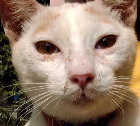1012Singapore
cat influenza sneezing coughing pet health and welfare educational for animal lovers,
excerpts from The
Glamorous Vets, Singapore, sponsored by AsiaHomes Internet.
A pragmatic cat Samaritan
"Doc, S.O.S (Save our Souls), quickly give this young cat the flu jab!" said Mrs
Tan, a middle-aged stout woman who would help up stray cats in distress but this cat did
not fit any emergency or traumatic scenario.
"The other cat had coughing and sneezing and had just been sent to the
veterinarian." I had never seen her before but she looked the typical "Ah
Soh (auntie)" in her dressing of a floral sleeve-less, collar-less silk blouse and
black long pants, reflecting the conservative dressing for many Singapore housewives in
their sixties.
She did not want this cat which was adopted by a family living in the Housing &
Development Board flat to become sick and would spend her own money at the veterinarian to
get it vaccinated.
"Do cat flu viruses infect people too?" Mrs Tan asked as she used a tissue paper
to wipe away her running nose. She was feeling cold inside the consultation room and
she thought she might have got infected by the flu virus of human beings.
"No," I said. I was more worried about the viruses from the short episodes of
unproductive coughing of Mrs Tan. Vets are not so immune to human flu virus unlike the
medical general practitioner who is exposed daily in this human flu epidemic season and
gets immune.
"The cat looks healthy and is eating well" said Mrs Tan. A cute
tri-coloured cat with more white than any other colour. Brown eyes like most stray cats in
Singapore. Not particularly handsome, nondescript cat commonly seen in Singapore's
hawker centres, wet markets and open air food courts.
"Was there any contact with the infected cat?" I asked. Since both cats were
living in the same flat, it sometimes sounded silly to ask such a question. One sneeze
from the other cat, just one, would spread an aerosol of millions of viruses to infect a
few thousand cats. The other cat was sneezing so frequently and this young cat must
have had been infected.
"Vaccination will not be effective if the cat had been exposed to the viruses of the
other cat," I said. "It takes 7-14 days after exposure to the virus to show the
signs and symptoms of coughing and sneezing. There is no point vaccinating this cat as it
will come down with cat flu despite vaccination and you will have spent your money in
vain."
"Doc, if every vet thinks like you and don't vaccinate the cat when asked to do
so," Mrs Tan lectured in her soft voice. "How do vets survive this
recession?" This was a most pragmatic Singaporean cat lover.
"If I leave now, your consultation is free," Mrs Tan continued. "Here you
are telling me that there is no point vaccinating this cat. Give what the customer wants
and don't talk too much," Mrs Tan admonished me with a smile.
 Seven days later,
the family which adopted the cat came with the same cat. It had an upper respiratory
infection as characterised by its sneezing and coughing. Its eyes were half closed,
as if they were sensitive to the glaring afternoon sunlight. The eye or conjunctival
membranes were of a deep red colour. Serous fluid streamed down from the nose like a mini
waterfall. It sneezed watery fluid onto the operating table. It did not cough much.
It must have muscle pains as well as fever, like people infected with flu virus but cats
can't talk about feeling muscle aches. It was just lethargic and wanted to lie
down. Seven days later,
the family which adopted the cat came with the same cat. It had an upper respiratory
infection as characterised by its sneezing and coughing. Its eyes were half closed,
as if they were sensitive to the glaring afternoon sunlight. The eye or conjunctival
membranes were of a deep red colour. Serous fluid streamed down from the nose like a mini
waterfall. It sneezed watery fluid onto the operating table. It did not cough much.
It must have muscle pains as well as fever, like people infected with flu virus but cats
can't talk about feeling muscle aches. It was just lethargic and wanted to lie
down.
"There are no drugs against viral infection," I said. "The fever and coughing can be controlled by medication. It will take
a few days for the cat to recover. It must rest at home and take medication." "The fever and coughing can be controlled by medication. It will take
a few days for the cat to recover. It must rest at home and take medication."
Vaccination in this case did not prevent the viral infection as the cat was incubating the
virus inside its body. Much now depends on its resistance and immunity to fight off
the viral attack. Lots of rest and water will be good for this cat.
Electron microscopic pictures
of viruses in people and animals. |